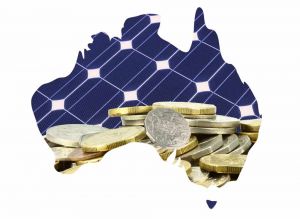While there are many good reasons for installing solar, it’s safe to say that most people look forward to saving money on their power bills. With so many factors coming into play – from the size of the panels, whether or not you install storage and even the shape of your roof – it’s hard to know what savings you should expect from your investment. Installing solar should certainly mean reduced electricity costs, but by how much? Wouldn’t it be great if you could see what Aussies who already have solar pay on their energy costs? We’ve got you.
With this information, we hope you’ll better understand what lies ahead on your solar installation journey, or what your current set-up should be doing for you.
On this page:
Advertisement
Average solar bill in Australia
Research conducted by Canstar Blue in December 2023 found that the average credit for households with solar panels was $104, based on survey respondents’ latest electricity bill. The largest solar rebates on bills were found in Queensland with $127 while Victorians reported a smaller $58 on their most recent bill. All other states and territories did not qualify for the minimum number of responses and have therefore been left out of this analysis.
Compare solar plans and prices
Here are some of the cheapest solar-specific deals from the retailers on our database. These costs are based on the Ausgrid network in Sydney but prices will vary depending on your circumstances. We show one product per retailer, listed in order of lowest price first. Annual price estimates assume general energy usage of 3900kWh/year for a residential customer on a single rate tariff. Price estimates exclude solar feed-in tariff credits. These are products from referral partners†. Our database may not cover all deals in your area, and please check retailer websites for up to date information.
Here are some of the cheapest solar-specific deals from the retailers on our database. These costs are based on the Citipower network in Melbourne but prices will vary depending on your circumstances. We show one product per retailer, listed in order of lowest price first. Annual price estimates assume general energy usage of 4000kWh/year for a residential customer on a single rate tariff. Price estimates exclude solar feed-in tariff credits. These are products from referral partners†. Our database may not cover all deals in your area, and please check retailer websites for up to date information.
Here are some of the cheapest solar-specific deals from the retailers on our database. These costs are based on the Energex network in Brisbane but prices will vary depending on your circumstances. We show one product per retailer, listed in order of lowest price first. Annual price estimates assume general energy usage of 4600kWh/year for a residential customer on a single rate tariff. Price estimates exclude solar feed-in tariff credits. These are products from referral partners†. Our database may not cover all deals in your area, and please check retailer websites for up to date information.
Here are some of the cheapest solar-specific deals from the retailers on our database. These costs are based on SA Power network in Adelaide but prices will vary depending on your circumstances. We show one product per retailer, listed in order of lowest price first. Annual price estimates assume general energy usage of 4000kWh/year for a residential customer on a single rate tariff. Price estimates exclude solar feed-in tariff credits. These are products from referral partners†. Our database may not cover all deals in your area, and please check retailer websites for up to date information.
How can I lower my solar bill?
If you’ve taken a look at the average amounts Australians receive for exporting electricity back into the grid and think you may be lagging behind the pack, it may be time to change up your energy habits. Here are some handy tips:

- Consider a plan with low rates: Whilst there are a good handful of deals on the market targeted towards solar households, sometimes a higher feed-in tariff could mean higher base rates as well. Remember that you’ll still be paying for your power when your panels aren’t working, so consider whether a low-rate plan would be better suited to your usage.
- Take a look at your feed-in tariff: If you’re in a position where your solar panels are generating energy to be put back into the grid, it’s a great idea to make sure you’re getting a good feed-in tariff. Visit our feed-in tariff guide to see what’s considered generous where you live.
- Consider installing a solar battery: Solar batteries work by storing the excess solar energy generated by your panels for use at a later time. This helps to make you less reliant on the grid, which could help to reduce your electricity bills. Be mindful that solar batteries can be a hefty upfront cost, so only install them if you’re sure you’ll eventually earn back what you paid.
- Maintain your solar panels: This should be made clear by your solar installer, but solar panels require maintenance in order to remain efficient. Have a chat to your specialist about how regularly you should be conducting this work.
- Be energy smart: The world’s best solar panels will be no use to a household that isn’t energy smart. Use energy efficient appliances, keep cooling and heating to a minimum and turn off lights when you leave the room to use up as little solar energy as possible.
Should I switch solar plans?
If you’re earning significantly less for your solar credits than the averages reported in this report, it could be worth re-evaluating your current plan. Whilst it’s not always your solar deal that’s doing most of the damage, it can’t hurt to leverage yourself into the best position possible for savings. You can visit any one of our solar pages or have a look at deals in our comparison tool offering feed-in tariffs to get started.
How much money do you save with solar panels in Australia?
One of the main reasons for Aussies to invest in solar is to reduce their electricity bills, but the amount of savings will depend on a variety of factors. As evident in our latest research, households with solar panels saved an average of $104 through solar credits on their last power bill.
How much do solar panels cost?
The price you’ll pay for solar panels will depend on the type, installer, size of the system, as well as factors like the positioning of your roof. That being said, Canstar Blue’s most recent solar survey found that households pay around $6,000 on average for an all-inclusive solar system package.
What are the pros and cons of solar?
Like any financial investment, there are pros and cons of solar to weigh up before making a purchase decision. Here are some advantages and disadvantages of solar:
| Pros | Cons |
|---|---|
| Helps reduce your energy bill | High upfront costs |
| Less reliant on grid electricity | Maximum output reliant on weather |
| Low maintenance | Less efficient over time |
Are solar panels a good investment in 2024?
Installing a PV system can be a solid investment, especially if it’s coupled with a competitive feed-in tariff, good energy habits or a solar battery. You’ll just need to do your homework and ring around for a few quotes to ensure you’re getting the most bang for your back. Most solar installers will be able to provide information according to your circumstances, like average payback periods and the appropriate size of system.




Share this article